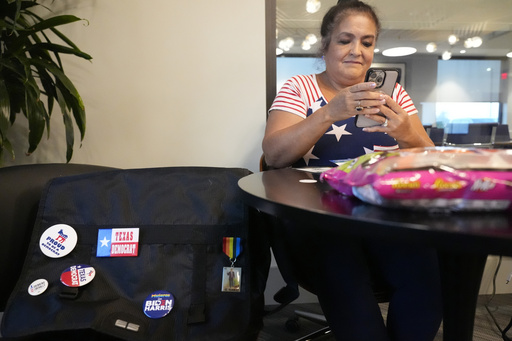
LEWISVILLE, Texas — Nestled within the expansive terrain of Texas, Lewisville exemplifies the diverse character of the Lone Star State. Located just 23 miles north of Dallas, the city is divided by Interstate 35 and features a network of six- and eight-lane roads filled with a mix of chain retailers, Mexican dining establishments, and pawn shops. The demographics show that the typical Lewisville resident is roughly 36 years old, mirroring the statewide average. The community is notable for its diversity, with around 60% of residents identifying as non-white. Approximately two-thirds of eligible voters in the city participated in the 2020 presidential elections, highlighting a politically-engaged populace.
In contrast, adjacent to Lewisville, Flower Mound showcases affluent neighborhoods with upscale names such as Teal Wood Oaks and Chaucer Estates. This nearby city appears to reflect the traditional Republican voter base in Texas, characterized by a predominantly white population, with over 66% identifying as such. Flower Mound also boasted a significant voter turnout, with around 78% participating in the 2020 elections. The differing demographics between Lewisville and Flower Mound frame a crucial narrative in Texas politics over recent decades.
Historically, it has been assumed that bridging the gap between the voter base of Lewisville, which represents a more diverse electorate, and Flower Mound’s predominantly white demographic would favor the Democratic Party. The rationale behind this assumption lies in the idea that increasing voter turnout among minorities, who typically lean Democratic, would weaken Republican support. However, the dynamics of the upcoming presidential election are altering this perspective.
The Republican campaign for Donald Trump appears to focus on engaging conservative-leaning voters who may not frequently participate in elections. His campaign is optimistic about attracting younger voters as well as Latino and African American demographics who tend to have lower turnout rates. On the other side, Democrat Kamala Harris aims to secure support from Black and Latino voters while also building rapport with the educated voter base that significantly contributed to Joe Biden’s victory in 2020.
The shifting political landscape in these neighboring cities is evident. In Flower Mound, Republicans who previously had a stronghold are now concerned about potential Democratic gains. Conversely, in the more diverse community of Lewisville, disengaged voters are beginning to show an interest in Trump.
Brandon Taylor, 35, who is unable to vote due to past criminal convictions, expressed his hope that Trump would make a difference, urging his girlfriend to consider voting for the former president. In stark contrast, Martha Mackenzie, a retired Naval officer and former Republican, departed from the party due to her disillusionment with Trump’s rhetoric and claims about the 2020 election.
Despite the ideological divide, both communities contain supporters for each political figure. This distinction extends beyond mere party affiliation and into the socio-economic fabric of the regions. Sally Ortega Putney highlighted how middle-class individuals are often the ones actively engaging in politics since they have the time to dedicate to such endeavors, reflecting a recurring trend across various electoral landscapes.
For over two decades, Republicans have dominated Texas’ political sphere, holding firm control of the Legislature and continuously winning statewide elections since 1994. Although the state has become more diverse, critics argue that the Republican party has adopted measures to fortify its power. This includes drawing controversial gerrymandered voting districts and implementing stricter election laws in response to various voter fraud allegations.
In 2021, Texas lawmakers enacted legislation to restrict voting practices that were gaining popularity, such as 24-hour voting, among predominantly Democratic counties. Tactics employed by the Republican establishment to suppress potential voters include legal actions against voter registration drives in Democratic-leaning areas and investigations targeting organizations aiding the Latino community.
However, the introduction of new voters hasn’t produced the outcomes Republicans initially feared. The 2018 Senate campaign of Beto O’Rourke against Ted Cruz saw a significant surge in voter turnout that nearly resulted in an upset for the GOP, highlighting the potential for a more competitive electorate. Political analysts emphasize that there remain untapped voting pools available to both major political parties.
Local Republican leader Lacey Riley asserts that current voting regulations aim to maintain electoral integrity rather than hinder participation. She expressed excitement about the GOP’s attempts to reach new voters, emphasizing the party’s evolution away from being merely associated with affluent white individuals.
As Flower Mound adapts to changing demographics, some residents are witnessing shifts in political sentiment. The city, founded in 1961, has historically emphasized slow growth and single-family homes, leading to contentious debates over development issues. In contrast, Lewisville has a rich history dating back to the 19th century, characterized by varied types of residential developments and a more diverse population.
Political engagement in Lewisville trails behind that of Flower Mound, partly due to structural barriers imposed by local governance aimed at thwarting Democratic voter turnout. Furthermore, a significant portion of the population in Lewisville consists of foreign-born residents who lack voting rights, further diluting the potential for political representation.
This reality brings anxiety to individuals like Jose Colmenares, a Venezuelan immigrant, who perceives Kamala Harris as a more favorable candidate for migrants compared to Trump, whose rhetoric often includes hostility towards immigrants. Colmenares joins others in voicing frustration over being unable to participate in the democratic process.
Even within the same local businesses, differing political opinions emerge as employees share their thoughts on the presidential race. Alex Salguero, a mechanic and business owner, expresses his disdain for Trump’s anti-immigrant sentiments, noting how they resonate negatively within the Latino community. In contrast, employee Ivan Barrera, despite sharing concerns about Trump’s language, leans toward supporting him, reflecting the complexities within voter behaviors and priorities. Barrera’s desire to influence his Mexican immigrant parents toward the Republican side underscores the multifaceted nature of political persuasion in their community.
